7.9.1: Biology - Polarizability of Biologically Significant Atoms
- Page ID
- 50811
Our next goal is to understand "noncovalent interactions". Noncovalent interactions hold together the two strands DNA in the double helix, convert linear proteins to 3D structures that are necessary for enzyme activity, and are the basis for antibody-antigen association. More importantly, noncovalent interactions between water molecules are probably the feature of water that is most important for biogenesis (the beginnings of life in the aqueous environment). Obviously, the topics of the next few sections, are of crucial importance to Biology. But in order to understand noncovalent interactions, we first need to develop a better understanding of the nature of bonds ranging from purely covalent to ionic.
In other sections, chemical bonds are divided into two classes: covalent bonds, in which electrons are shared between atomic nuclei, and ionic bonds, in which electrons are transferred from one atom to the other. However, a sharp distinction between these two classes cannot be made. Unless both nuclei are the same (as in H2), an electron pair is never shared equally by both nuclei. There is thus some degree of electron transfer as well as electron sharing in most covalent bonds. On the other hand there is never a complete transfer of an electron from one nucleus to another in ionic compounds. The first nucleus always maintains some slight residual control over the transferred electron.
Pure Covalent Bonds
Pure Covalent Bonds are those in which electrons are shared equally between the two atoms involved. This can only happen for pairs of identical atoms. Iodine is a purple/black solid made up of \(\ce{I2}\) molecules, which should have a pure covalent bond by sharing 5p electrons. It's toxic and, in solution, used as a bacteriocide. The net charge on each atom is 0, meaning that the charge is the same as if it were an isolated \(\ce{I}\) atom.
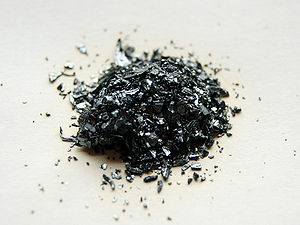
Another way of showing charge distribution is with an electrostatic potential map, where blue indicates positive charge and red indicates negative charge in regions of space around the two nuclei. Notice that the charge distribution is identical on the two iodines, although it is not uniformly distributed on either one (there's a positive region on the ends of the molecule, which probably results from electrons along the axis being drawn into the bond between the nuclei:
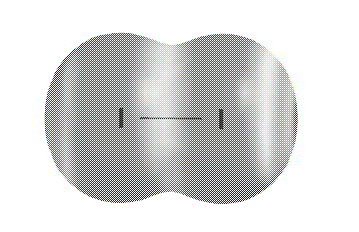
It is curious that the iodine molecule, with no net charges on either atom, should attract other iodine molecules to make a solid. This exemplifies one kind of attraction important in biomolecules, the van der Waals attraction, and we'll discuss that a lot more later. It's not the most important kind of attraction, however. To see how stronger attractions between molecules arise, we need to see what happens when we change the \(\ce{I2}\) molecule slightly.
Polarizability of iodine atoms
Suppose we now change one \(\ce{I}\) atom to atoms in Group I: a \(\ce{Li}\) atom, \(\ce{Na}\) atom, and \(\ce{Cs}\) atom in succession. The products, lithium iodide (\(\ce{LiI}\)), sodium iodide (\(\ce{NaI}\)), and cesium iodide (\(\ce{CsI}\)) look like typical ionic compounds; they are all white crystalline solids. \(\ce{NaI}\) is used as a source of "iodine" (actually iodide) for "iodized salt", and looks just like \(\ce{NaCl}\). But the relatively low melting point of \(\ce{LiI}\) (459oC) is suggestive of covalent bonding. It is important to realize that all of these compounds exist as crystal lattices, not individual molecules, under ordinary conditions. The individual molecules that we're discussing are gas phase species, modeled in a vacuum. \(\ce{LiI}\) and its crystal lattice are shown here:

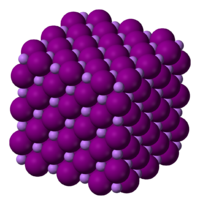
The electrostatic potential surface confirms that there is sharing of electrons in \(\ce{LiF}\), because there is only a slight minimum in electron density between the atoms, and \(\ce{Li}\) has clearly distorted the spherical distribution of electrons on \(\ce{I}\), showing that electrons are shared. In a purely ionic compound, there would be virtually no electron density between the two spherical electron clouds of the ions.

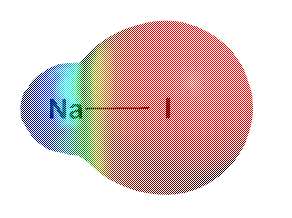
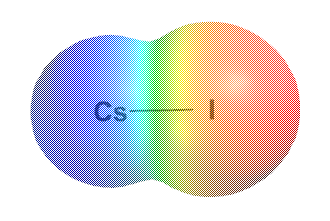
We say that the small \(\ce{Li^{+}}\) ion distorts, or polarizes the large electron cloud of \(\ce{I^{-}}\). Large anions (negative ions) are easily polarized, while smaller ones, like F- are much less polarizable because the electrons are held more tightly. We see that small cations (positive ions) like \(\ce{Li^{+}}\) are strong polarizers, while larger cations, like \(\ce{Na^{+}}\) or \(\ce{Cs^{+}}\) are less effective polarizers.
Because \(\ce{Cs^{+}}\) is least effective in polarizing \(\ce{I^{-}}\), \(\ce{CsI}\) is the most ionic of the three. The electron cloud around the \(\ce{I^{-}}\) is almost spherical (undistorted), and there is a definite decrease in electron density in the region between \(\ce{Cs}\) and \(\ce{I}\). But there is still some sharing of electrons in \(\ce{CsI}\), because we do not see a region of zero electron density between two spherical ions. This is, in part, due to the fact that \(\ce{Cs}\) is large (near the bottom of Group I), so it is also slightly polarized by the iodine core.
Dipole Moments
The extent of polarization in \(\ce{LiI}\) can be confirmed experimentally. An ion pair like \(\ce{LiI}\) has a negative end (\(\ce{I^{–}}\)) and a positive end (\(\ce{Li^{+}}\)). That is, it has two electrical “poles,” like the north and south magnetic poles of a magnet. The ion pair is therefore an electrical dipole (literally “two poles“), and a quantity known as its dipole moment may be determined from experimental measurements. The dipole moment \(μ\) is proportional to the size of the separated electrical charges \(Q\) and to the distance \(r\) between them:
\[μ = Qr \label{1} \]
In the \(\ce{LiI}\) ion pair the two nuclei are known to be separated by a distance of 239.2 pm.
If the bond were completely ionic, there would be a net charge of –1.6021 × 10–19 C (the electronic charge) centered on the \(\ce{I}\) nucleus and a charge of +1.6021 × 10–19 C centered on the Li nucleus:
The dipole moment would then be given (via Equation \ref{1}):
\[\begin{align*} μ &= Qr \\[4pt] &= 1.6021 × 10^{–19} C × 239.2 × 10^{–12}\, m \\[4pt] &= 3.832 × 10^{–29}\, C\, m \end{align*} \nonumber \]
The measured value of the dipole moment for the \(\ce{LiH}\) ion pair is 2.43× 10–29 C m, which is only about 64% of this value. This can only be because the negative charge is not centered on the \(\ce{I}\) nucleus but shifted somewhat toward the \(\ce{Li^{+}}\) nucleus. This shift brings the opposite charges closer together, and the experimental dipole moment is smaller than would be expected.
As the bond becomes less polarized, there is less electron sharing and the bond becomes more ionic. In the case of \(\ce{CsI}\), the charge is 0.822 e, so the dipole moment is 82% of the theoretical value for a totally ionic species. The bond distance is 270.0 pm, so the dipole moment is
\[\begin{align*} μ &= Qr \\[4pt] &= 0.822\, e × 1.6021 × 10^{–19} C/e × 270.0 × 10^{–12} m \\[4pt] &= 3.56 × 10^{–29}\, C\, m \end{align*} \nonumber \]
The polarization of the bond in \(\ce{LiI}\) gives it very different properties than the nonpolar \(\ce{I2}\). It's interesting that the blood/brain barrier allows nonpolar molecules, like \(\ce{O2}\) to pass freely, while more polar molecules may be prohibited. Ionic species, like the \(\ce{Li^{+}}\) and \(\ce{I^{–}}\) that result from dissolving \(\ce{LiI}\) in water, require special carrier-mediated transport mechanism which moderates the ion levels in the brain, even when plasma levels fluctuate significantly.


